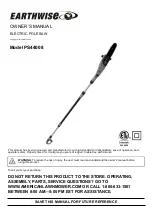
8
FENCE
– Helps to keep the workpiece
from moving when sawing. Scaled to
assist with accurate cutting.
GUARD
– Protective devise that forms
a barrier between a hazardous object
such as a blade, wheel or cutter and the
operator.
HOLD-DOWN LATCH
– Locks the miter
saw in the lowered position for compact
storage and transportation.
INSTRUCTION MANUAL
– Booklet
accompanying your power tool that
describes the hazards and safe operation
procedures, outlines basic tool operation,
care and maintenance.
MITER HANDLE
– Used to rotate the
table, and to rotate the saw to a right or
left cutting position.
MITER SCALE
– Measures the miter
angle of the saw blade. Positive stop
index points have been provided at 0°,
15°, 22.5°, 31.6° and 45° right and left.
MOUNTING HOLES
– To mount the miter
saw to a stable surface.
ON/OFF TRIGGER SWITCH
– To start
the tool, squeeze the trigger. Release the
trigger to turn off the miter saw.
POSITIVE STOP LOCKING LEVER
–
Locks the miter saw at a preset positive
stop for the desired miter angle.
SWITCH HANDLE
– The switch handle
contains the trigger switch and the laser
on/off switch. The blade is lowered into
the workpiece by pushing down on the
handle. The saw will return to its upright
position when the handle is released.
WARNING LABELS
– Read and
understand for your own safety. Make
sure all labels are present on machine and
legible.
BLADE WRENCH STORAGE
–
Convenient storage to prevent misplacing
the blade wrench.
WOODWORKING TERMS
ARBOR
– The shaft on which a blade is
mounted.
BEVEL CUT
– An angle cut made through
the face of the workpiece.
COMPOUND CUT
– An angled cut to
both the edge and face of a board, most
common use is with crown molding.
CROSS CUT
– A cut which runs across
the board perpendicular to the grain.
FREEHAND
– Performing a cut without
using a fence (guide), hold down or other
proper device to prevent the workpiece
from twisting during the cutting operation.
HEEL
– Misalignment of the blade.
KERF
– The width of a saw cut,
determined by the thickness and set of the
blade.
KICKBACK
– sudden and unintended
movement of the tool or workpiece. It is
typically caused by binding or pinching of
the workpiece.
MITER CUT
– A miter is a type of joint
where the two parts to be joined are cut
at an angle, and typically the finished joint
forms a 90-degree angle. Also commonly
spelled “mitre”.
REVOLUTIONS PER MINUTE (RPM)
– The number of turns completed by a
spinning object in one minute.
SAW BLADE PATH
– The area of the
workpiece or table top directly in line with
the travel of the blade or the part of the
workpiece which will be cut.
SET
– The distance between two saw
blade tips, bent outward in opposite
directions to each other. The further apart
the tips are, the greater the set.
THIN-KERF BLADE
– Thinner than
normal blades, remove less material,
smaller kerfs (between 0.065 in. and
0.070 in.). Blade thinness also may
increase the heat generated while cutting.
WORKPIECE
– The wood being cut. The
surfaces of a workpiece are commonly
referred to as faces, ends and edges.









































